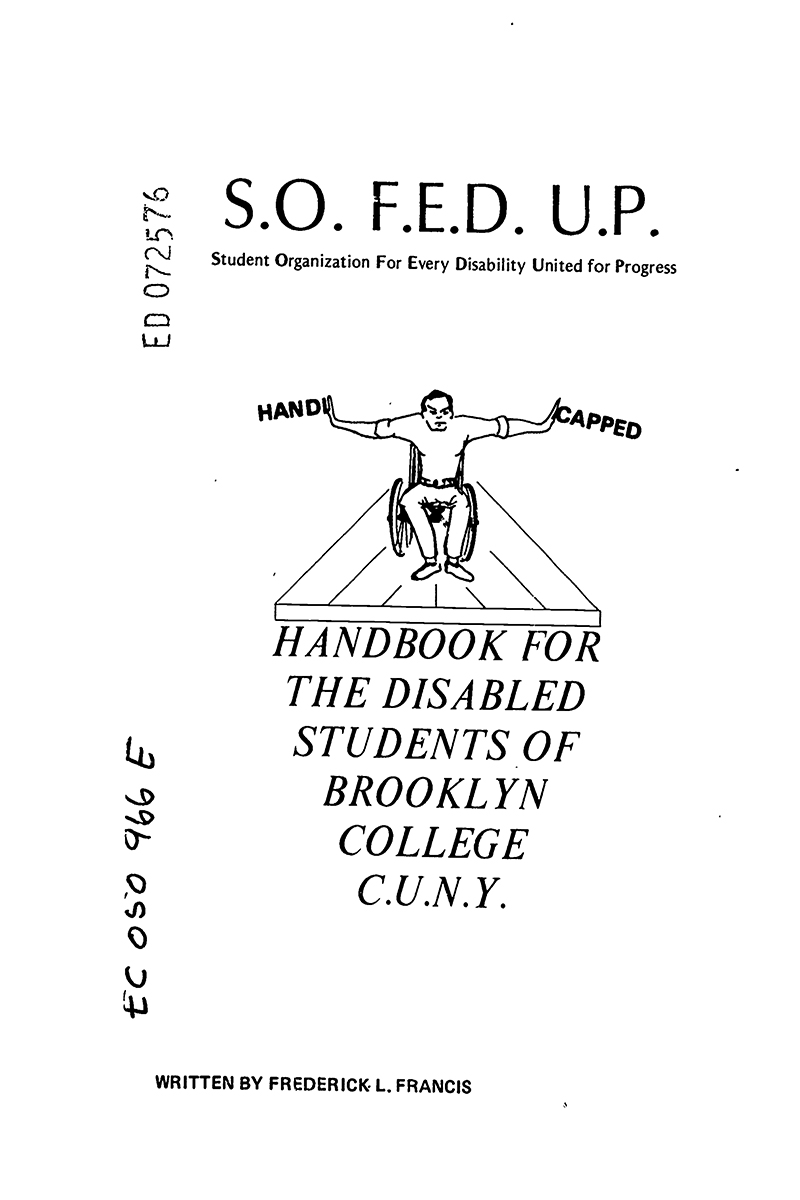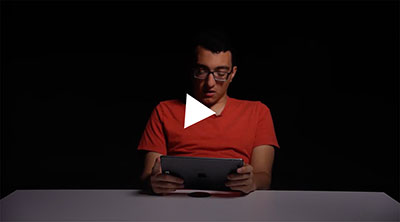You are here:
S.O. F.E.D. U.P. Handbook for the Disabled Students of Brooklyn College, CUNY, excerpt

Date: 1971
Caption: S.O.F.E.D.U.P., “Students Organized For Every Disability United for Progress,” was founded at Brooklyn College to promote activism by and for Disabled students to eliminate architectural and bureaucratic barriers and increase educational access. Their handbook described their goals and vision.
The late 1960s and early 1970s saw campus activism around the United States, for social change and against the Vietnam War. In New York City, students at various campuses of the City University of New York organized and protested in ways that changed their colleges and universities in the late 1960s and early 1970s. At City College, students organized a takeover of the campus demanding admission of more Black and Latinx students to the predominantly white campus in Harlem. At Brooklyn College, students pushed successfully for the founding of programs in Africana Studies and Puerto Rican Studies.1
Disabled students were part of this activist wave. At Brooklyn College, students Frederick Frances, Pat Figueroa, Arthur Lefkin, and others created an organization called S.O.F.E.D.U.P. - Students Organized for Every Disability United for Progress. Frances described himself as an “above-knee bilateral amputee” who had been injured in a car accident.2 Figueroa was born with spina bifida. Like other students with physical disabilities, both faced architectural barriers to access as students and members of the campus community at Brooklyn College. Few buildings had ramps, for example, and bathrooms and classrooms were inaccessible.
S.O.F.E.D.U.P. succeeded in lobbying Brooklyn College administrators to make campus facilities more accessible. Their work helped spark student activism on other campuses, and many of its members later contributed to other disability rights organizations, including Disabled in Action. Their efforts, like those of other activist groups, gradually helped create political pressure and will to bring about change, including in the Americans with Disabilities Act of 1990.3
-
Martha Biondi, Black Revolution on Campus (Oakland: University of California Press, 2012). ↩︎
-
Frederick L. Frances, preface to “S.O. F.E.D. U.P. - Handbook for the Disabled Students of Brooklyn College,” 1971, via Education Research Information Center. ↩︎
-
Kim E. Nielsen, A Disability History of the United States, 2nd ed. (Boston: Beacon Press, 2012). ↩︎
Watch a close reading of this document

Categories: student activism, higher education, Brooklyn
Tags: physical disabilities, self-advocacy, architectural barriers, Disabled people, organizing, racist segregation, employment, curriculum, photography, imagery, and visual representation, student writing, disability labels
This item is part of "Fighting to Fit In: Physical Access" in "Seeking Equity for Disabled Students"
Item Details
Date: 1971
Creator: Frederick L. Francis
Source: Education Resources Information Center (ERIC)
Copyright: Under copyright.
How to cite: “S.O. F.E.D. U.P. Handbook for the Disabled Students of Brooklyn College, CUNY, excerpt,” Frederick L. Francis, in New York City Civil Rights History Project, Accessed: [Month Day, Year], https://nyccivilrightshistory.org/gallery/sofedup-handbook.
Questions to Consider
- How does the image on the cover of the handbook make you feel? What message do you think the authors wanted to send with this image? What did they think of the term “handicapped”?
- What passages from the text stand out to you? How did S.O.F.E.D.U.P. use the language of civil rights movements and ideas to make their case?
- What was S.O.F.E.D.U.P. trying to accomplish? How did they plan to go about it through their organizing?
- S.O.F.E.D.U.P. describes itself as an organization for “Every Disability United for Progress.” In what ways are students of “every disability” included, or not included, in Francis’s statement?
References
How to Print this Page
- Press Ctrl + P or Cmd + P to open the print dialogue window.
- Under settings, choose "display headers and footers" if you want to print page numbers and the web address.
- Embedded PDF files will not print as part of the page. For best printing results, download the PDF and print from Adobe Reader or Preview.
